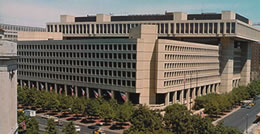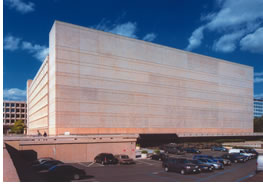
Evaluating Modernist buildings approaching middle age

The Foundation is working closely with the General Services Administration (GSA) in the agency's evaluation of federal buildings from the 1960s and '70s-an effort that has evolved from a December 5 event GSA held at Yale University, "Architecture of the Great Society."
As reported in the February 2001 AIArchitect, conclusions from the forum included an expressed need to combine practicality and creativity to study adaptive reuse of these federal facilities so they continue to serve the community, respect the intent behind the buildings' design, and educate and inspire the public and design professions.
"Take a curatorial attitude toward our buildings," exhorted forum host Robert A.M. Stern, FAIA, dean of the Yale Architecture School. "We must have the courage to separate bad from good."
 To
that end, GSA has established a blue-ribbon panel to examine the federal
building stock that is now eligible for Federal Register of Historic Places
status, or close to being so. The AAF is a valued contributor to these
discussions. Currently, the Architecture of the Great Society project,
under the direction of the GSA Historic Buildings Program, is defining
criteria to evaluate buildings from the 1960s and '70s, what processes
GSA should undertake for the inventory evaluation, and how the many factors
that make up building-value assessment should be balanced.
To
that end, GSA has established a blue-ribbon panel to examine the federal
building stock that is now eligible for Federal Register of Historic Places
status, or close to being so. The AAF is a valued contributor to these
discussions. Currently, the Architecture of the Great Society project,
under the direction of the GSA Historic Buildings Program, is defining
criteria to evaluate buildings from the 1960s and '70s, what processes
GSA should undertake for the inventory evaluation, and how the many factors
that make up building-value assessment should be balanced.
A short history
A grand realization of what Americans are capable of accomplishing came
from the World War II experience. Among the outgrowths of that recognition
were trends toward expediency, abandonment of tradition, and innovation
in the interest of speed and practicality. Within a decade, the war turned
the nation from a conservative Great Depression mentality to one of innovation
through talent and energy and a willingness to take risks at the drop
of a hat. When it came to erecting our new generation of buildings, the
great victory left us with the sense that we could build afresh without
the traditional reliance on architectural antecedents.
The result, of course, was widespread adherence to the basic tenets of Modernism—use of modern materials, unique shapes and forms that had faint derivation in historical models, new ways of siting and relating to existing buildings, new technical systems and ways of bringing light in to the occupants, etc. All of a sudden, this dramatic swing in attitude left designers of traditional buildings almost as isolated and rare in the postwar years as Modernists had been before hostilities erupted.
All this invention served up its share of inspired buildings and places, but much of the new also had accompanying failures and shortfalls. Great care and perception led to brilliant triumphs such as Mies van der Rohe's Seagram Building (1954–8), Saarinen's Dulles Airport (1958–62), and Kahn's Richards Medical Research Laboratories (1957–61). But also out there were many examples that can only be described as construction junk, created by the less skilled who didn't grasp the real potential and complexities of this new design wave.
Modernism—with its triumphs and embarrassments alike—had developed a full head of steam by the 1960s and '70s—just in time for Lyndon Johnson's "Great Society." Of course the largest single client and building manager at the time was the U.S. government, through GSA, which put in place more than 700 major projects across the nation during those two decades. Mostly office buildings—but also courthouses, laboratories, museums, libraries, and border stations—GSA projects encompassed every building type imaginable. When one factors in embassy construction, it is fair to say that GSA's impact extended throughout the world.
Viewing these buildings with the benefit of hindsight, it is not surprising that opinion regarding them is mixed. There are a handful of brilliant buildings, a number of truly bad ones, and a vast inventory of still-viable structures of middling quality.
Now GSA must look at these aging buildings and determine their future. Unfortunately, the task isn't as straightforward as doing a physical inventory and estimating repair cost. Critical opinion of Modernism in recent decades tends toward cynicism. The pendulum of architectural style has seemingly swung far away from the absolute insistence of Modernism that arose after World War II and toward a much more romantic and tradition-based aesthetic. At present, there is a real risk of overly harsh judgment of the Great Society office buildings by GSA and others.
Thus, GSA has called for thoughtful reflection. It has initiated the review of its buildings by a selection of prominent architectural thinkers and others. The goal is to arrive at an approach that can be used to make fair judgment about the worth and value of these buildings, then determine the most appropriate way to proceed.
 Buildings
both interesting and comfortable
Buildings
both interesting and comfortable
Certain unforeseen outcomes are beginning to emerge from this still-young
initiative. The first is the emergence of a stronger-than-expected voice
for sensitivity. Certain of the prominent architects among those participating
are calling for a broad historical view of these buildings-suggesting
that an appreciation for many of these buildings exists that the current
stylistic preoccupation might have us ignore. After all, these buildings,
taken as a whole, are the signature of an entire era and deserve to be
looked at with their historical implications truly understood.
The second is that many of these buildings may be marginal in the eyes of the detached viewer from afar, but, as time has passed, the local citizens have come to embrace them as important to their sense of community spirit. This feeling demands recognition and should be factored into any evaluation concerning the destiny of these buildings.
Third, the way that the evaluation is handled will broadcast an important message to the local users and residents of the communities in which these buildings reside. The message will reflect for better or for worse on people's opinions concerning the sensitivity of the federal government.
Given all this, there is clearly the need to involve the public in writing the future of these buildings. The key, of course, is to impose balance to temper reflex judgment and emotional considerations on the one hand and too much insistence on practical considerations on the other.
Naturally, there will be buildings among these that will disappear on their merits. But if the process of review and evaluation is wisely applied, many of these GSA buildings will have a future of great service and will, at the same time, speak favorably not only of their builders, but of those who gave them appropriate care and consideration as they matured.
It is important for GSA to be successful in arriving at the best strategy for the consideration of these buildings, because GSA has the unique opportunity to set the model for the consideration of all the other buildings that came into being during the postwar era. If GSA succeeds, it will be setting a new high standard for government responsiveness to both history and the good of the people, while doing service to the architectural culture of America.
The American Architectural Foundation feels the weight and importance of this undertaking and is pleased to be a partner with GSA in this effort. We are in the information business, with the mission of helping people understand the importance of architecture in their lives. Given that, we look forward to working with GSA in making the appropriate connections with citizens around the nation as GSA goes about the vital business of determining the destinies of their buildings and, to an important degree, the destinies of the very communities in which they exist.
Copyright 2001 The American Institute of Architects. All rights reserved.
![]()
|
Article from February AIArchitect "AAF Partners with GSA to Host Meetings" |
|